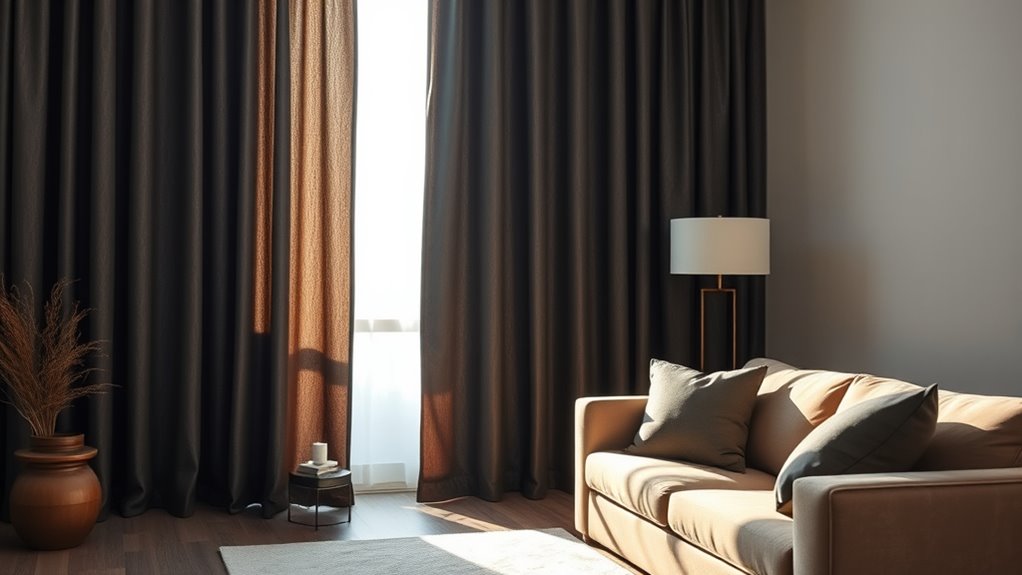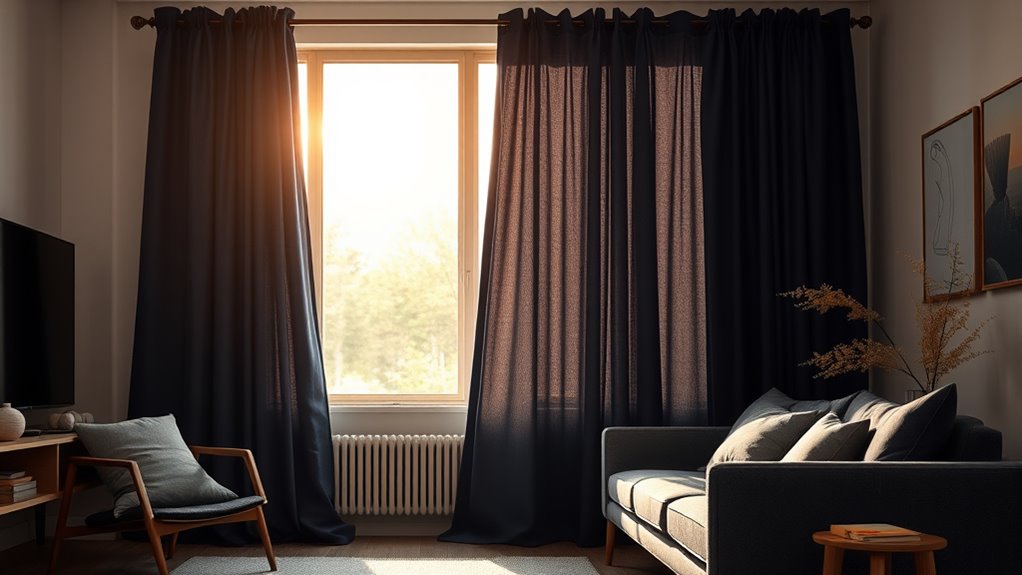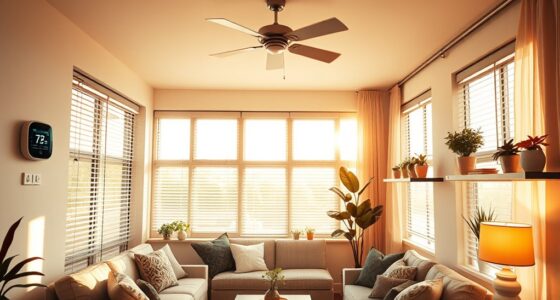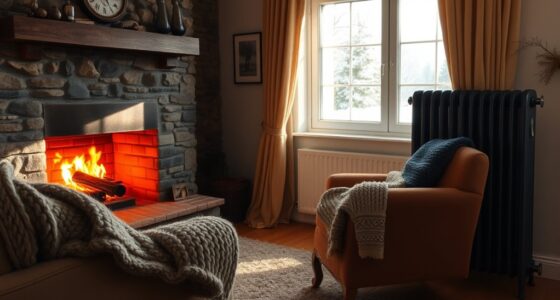Thermal drapes are a smart choice because they help you save money by improving your home’s insulation. They block drafts in winter and reduce heat gain in summer, which lowers your energy bills. Made with insulating layers like foam backing and thermal linings, they keep warm air inside and hot air out. Plus, they dampen noise and block light, making your home more comfortable. Keep exploring to discover how these drapes can make a real difference for you.
Key Takeaways
- Thermal drapes improve home insulation by reducing heat transfer, lowering energy costs for heating and cooling.
- They contain insulating layers like foam or thermal lining that enhance energy efficiency.
- Over time, energy savings from reduced utility bills offset the initial investment in thermal drapes.
- Thermal drapes help maintain indoor comfort, decreasing reliance on HVAC systems.
- Their dual function of insulation and noise reduction offers added value, making them a cost-effective home improvement.

Have you ever wondered what makes curtains both functional and beautiful? It’s not just about adding style to your space; it’s about how they work behind the scenes to improve comfort and save money. Thermal drapes are a perfect example. These specialized curtains are designed with insulating fabrics that help regulate indoor temperatures by blocking cold drafts in winter and heat gain in summer. When you hang thermal drapes, you’re not just enhancing your room’s aesthetic—you’re investing in energy efficiency. They act as a barrier, minimizing the amount of heat that escapes through windows, which is often the biggest source of energy loss in homes. During colder months, they trap warm air inside, making your heating system’s job easier, while in summer, they prevent unwanted heat from seeping in. This means your air conditioner or heater doesn’t have to work as hard to maintain a comfortable temperature, leading to lower utility bills.
Thermal drapes improve comfort and energy efficiency by blocking drafts and heat transfer.
Thermal drapes often incorporate multiple layers of insulating material, such as foam backing or thermal lining, which amplifies their ability to keep temperatures steady. The fabric itself isn’t just chosen for visual appeal; it’s selected for its thermal properties. Heavyweight fabrics like velvet or specialized synthetic blends are common because they provide better insulation. You might think that thick curtains look bulky or outdated, but modern thermal drapes come in sleek, stylish designs that blend seamlessly with contemporary decor. Plus, they’re easy to install and maintain, making them a practical choice for any room.
Another advantage is noise reduction. The same insulating qualities that help maintain temperature also dampen sound, creating a quieter, more peaceful environment inside your home. If you live near busy streets or noisy neighbors, thermal drapes can help you enjoy a quieter space. And since they’re effective at blocking light, they can also improve your sleep quality by darkening rooms, which is especially useful for shift workers or anyone who wants to sleep in on weekends.
In addition, the advanced insulating fabrics used in thermal drapes often feature reflective or thermal backing layers that further enhance their energy-saving capabilities. The same insulating qualities that help maintain temperature also dampen sound, creating a quieter, more peaceful environment inside your home. If you live near busy streets or noisy neighbors, thermal drapes can help you enjoy a quieter space. And since they’re effective at blocking light, they can also improve your sleep quality by darkening rooms, which is especially useful for shift workers or anyone who wants to sleep in on weekends.
In essence, investing in thermal drapes means you’re paying for a solution that benefits your comfort, your wallet, and your home’s energy efficiency. They’re a smart choice for anyone looking to cut heating and cooling costs while still maintaining a stylish interior. You’ll find that, over time, the savings on your energy bills more than make up for the initial expense. So, when you choose thermal drapes, you’re not just picking window coverings—you’re making a conscious decision to enhance your home’s comfort and efficiency in a stylish, sustainable way.
Frequently Asked Questions
How Long Does It Typically Take for Thermal Drapes to Recoup Their Cost?
It typically takes about 1 to 3 years for thermal drapes to recoup their initial cost. This varies depending on your climate, energy usage, and the size of your windows. You’ll see savings on your heating and cooling bills pretty quickly, especially during extreme weather. By reducing energy loss, thermal drapes help you save money long-term, making them a smart investment that pays for itself faster than you might expect.
Are Thermal Curtains Effective in All Climate Zones?
In the grand scheme of things, thermal curtains are quite effective across most climate zones, provided you choose the right type. They work well in cold or hot environments by insulating your space, but their efficiency varies depending on factors like window size and placement. You might need to supplement them with other measures in extreme climates, but generally, they’re a smart, economical upgrade regardless of where you live.
Can Thermal Drapes Be Used Alongside Existing Window Treatments?
Yes, you can definitely use thermal drapes alongside your existing window treatments. They work well together, enhancing insulation and energy efficiency. For example, pairing thermal drapes with blinds or curtains provides an extra layer of insulation, helping you save on heating and cooling costs. Just make certain the materials complement each other, and you’ll enjoy better temperature control without sacrificing style or convenience.
What Maintenance Is Required to Keep Thermal Drapes Functional?
To keep your thermal drapes functioning well, regularly vacuum or shake out dust and debris to prevent buildup. Spot clean stains with a damp cloth and mild detergent, avoiding harsh chemicals. Check the hems and seams periodically for wear or tears, and repair them promptly. Make sure the rods and hardware stay secure, and open or close the drapes gently to avoid unnecessary strain. Proper care guarantees they stay effective and last longer.
Do Thermal Drapes Impact Indoor Air Quality or Humidity Levels?
A stitch in time saves nine, and thermal drapes do more than just insulate. They generally don’t impact indoor air quality or humidity levels if you keep them clean and well-maintained. However, if dust or mold accumulate, they could affect air quality. Regular vacuuming and washing help prevent this, ensuring your environment stays fresh and healthy without compromising comfort or air standards.
Conclusion
By choosing thermal drapes, you’re not just improving your home’s comfort—you’re saving money in the long run. They pay for themselves over time, proving that “a penny saved is a penny earned.” So, why wait? Invest in smarter curtains today, and enjoy cozy winters and cooler summers without breaking the bank. Remember, small changes can make a big difference—sometimes, the simplest solutions are the best.









